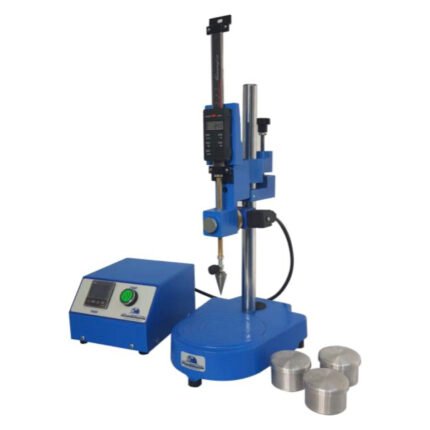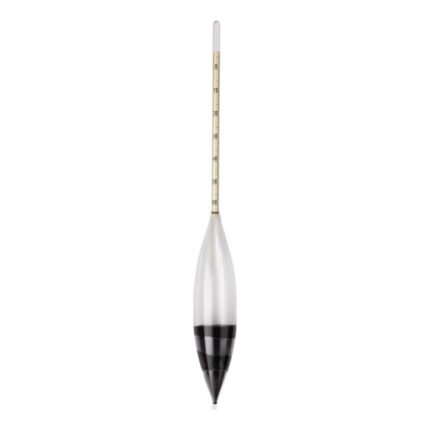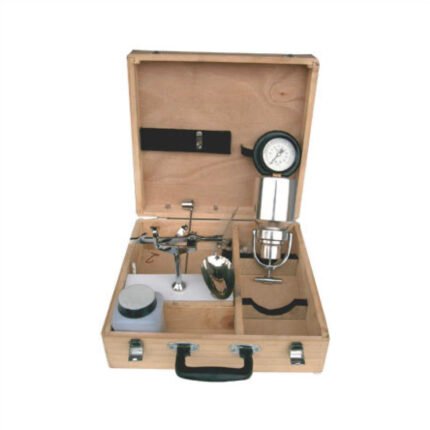AZA 0857 PARTICLE SIZE SEDIMENTATION (HYDROMETER METHOD)
- Particle size distribution using hydrometer sedimentation
- Suitable for clays and silts below 75 microns
- Conforms to IS 2720 Part IV & ASTM D422
- Includes hydrometer, sedimentation cylinder, thermometer
- Accurate readings of soil particle settlement over time
- Ideal for soil mechanics, civil and geotechnical labs
Description
Particle Size Sedimentation Hydrometer Method – Azalab
The Particle Size Sedimentation (Hydrometer Method) is a laboratory procedure used for determining the grain size distribution of fine soils, particularly those that are smaller than 75 microns in diameter such as silts and clays. Offered by Azalab, this method is essential in geotechnical engineering, soil mechanics, civil construction, and environmental research to understand the behavior of cohesive soils.
The hydrometer method measures the relative density of a soil-water suspension at different depths and times, using the principle of sedimentation based on Stokes’ Law. As the soil particles settle, the hydrometer records changes in the suspension density, helping determine the percentage of particles of various sizes. AZALAB
Particle size analysis of soils:
Hydrometer method
This equipment is used to determine the quantitative
size distribution of very fine particle in soils such as clay
and silt.
The complete set comprises:
! Sedimentation Cylinder, 1000 ml capacity (6 pieces) with rubber bungs.
! Soil Hydrometer, 151H, range 0.995 to 1.038g/ml with div. 0.001 Glass Tank, dimensions: 600x300x380 mm
! Heater complete with thermostat, circulation unit. 230V Single Phase 50Hz 1000W
! Glass Thermometer, range -10 to 50° C., Sub-div. 0.5° C.
! Beaker, Borosilicate Glass, 250 ml capacity
! Sodium Hexametaphosphate, 1000 g
! High Speed Stirrer, 4000 R.P.M, complete with baffle cup, for dispersing soil
particles in water.
What Is Included in the Apparatus?
-
Hydrometer (151H or ASTM Type): Measures relative density (g/L) of soil suspension
-
1000 ml Sedimentation Cylinder: Borosilicate glass cylinder for soil-water mix
-
Thermometer: For water temperature correction (typically 0–50°C range)
-
Dispersing Agent: Usually sodium hexametaphosphate (user-supplied)
-
Measuring Cylinder and Stirring Rod: For consistent sample preparation
-
Timing Device: Digital stopwatch for sedimentation tracking
How the Hydrometer Method Works
This method is based on the principle that soil particles of different sizes settle at different rates in a liquid. A representative soil sample is mixed with a dispersing agent and placed in a sedimentation cylinder. Over time, the hydrometer measures the density of the soil suspension at regular intervals (e.g., 2 minutes, 5 minutes, 1 hour, etc.). AZALAB
Each reading provides information about the fraction of particles still suspended in the liquid at that time, allowing precise calculation of the grain size distribution for particles smaller than those measurable by sieving. AZALAB+PRACTICAL SIZE
Applications
-
Geotechnical Investigations: Determines soil classification for foundation and earthwork designs
-
Soil Mechanics Education: Widely used in universities for academic demonstration
-
Civil Engineering: Essential for road, embankment, and dam construction analysis
-
Environmental Testing: Classifies sediments in lakes, rivers, and wetlands
Specifications Table
| Component | Specification |
|---|---|
| Hydrometer Type | ASTM 151H or IS-compliant Glass Hydrometer |
| Sedimentation Cylinder | 1000 ml Borosilicate Glass, Graduated |
| Temperature Range | 0°C to 50°C (thermometer included) |
| Dispersing Agent | Sodium Hexametaphosphate (not included) |
| Measurement Interval | 2 min to 24 hours (user-defined) |
| Standard Compliance | IS 2720 Part IV, ASTM D422, BS 1377 |
Frequently Asked Questions (FAQ)
Q1: What is the hydrometer method used for?
A: It is used to determine the grain size distribution of fine soils (silt and clay) through sedimentation analysis.
Q2: How accurate is the hydrometer method compared to sieve analysis?
A: It is more accurate for particles smaller than 75 microns, which cannot be classified reliably using sieves.
Q3: Is this method suitable for sandy soils?
A: No, it is specifically intended for fine-grained soils. Coarse particles settle too quickly for accurate hydrometer measurement.
Q4: What standards does this method follow?
A: It complies with IS 2720 Part IV, ASTM D422, and BS 1377.
Q5: Does the apparatus include a dispersing agent?
A: No, but sodium hexametaphosphate can be easily sourced separately for accurate dispersion.
Additional information
| Hydrometer Type |
ASTM 151H or IS-compliant Glass Hydrometer |
|---|---|
| Temperature Range |
0°C to 50°C (thermometer included) |
| Measurement Interval |
2 min to 24 hours (user-defined) |
You may also like…
AZA 0786 CEMENT SAMPLER
AZA 0787 BLAINE’S AIR PERMEABILITY APPARATUS
IS 4031, 5516, 1727 & 4828, ASTM C-204, BS 4359-2
Specification: Designed to find out specific gravities of semi liquids like mud and other liquids having densities in the range 0.8 to 2.5. It has a stainless steel bam calibrated specific gravities from 0.8 to 2.5. A stainless-steel cup with lid and overflow vent is fitted on one side of the beam. A counter weight with cursor slides over the graduated scale. The beam has a knife-edge at center which rests in a fulcrum fitted in the stand. Leveling screws and spirit level are fitted to the stand.
Spares & Accessories (On Extra Cost):
Punch to cut filter paper discs. Non-perforated disc. Suction bulb, Mercury.
AZA 0788 VICAT NEEDLE APPARATUS WITH DASHPOT
AZA 0789 RING MOULD
AZA 0792 FLOW TABLE (MOTORISED)
AZA 0793 FLOW TABLE
Related products
AZA 0852 SEMI AUTOMATIC CONE PENETROMETER
AZA 0853 LIQUID LIMIT DEVICE WITH COUNTER
AZA 0854 LIQUID LIMIT DEVICE (MOTORISED)
AZA 0858 SOIL HYDROMETER
AZA 0861 MOTORISED SAND EQUIVALENT SHAKER
AZA 0863 STANDARD COMPACTION TEST
- Standard Compaction Test: Specifically designed to perform the Standard Proctor Compaction Test.
- Fundamental Soil Property: Determines the maximum dry density and optimum moisture content of soils.
- Essential for Earthwork: Crucial for quality control in road construction, embankments, and foundations.
- Complete Apparatus: Includes a robust compaction mould, standard rammer, and necessary accessories.
- Standard Compliant: Adheres to international standards such as ASTM D698 and equivalent IS/BS norms.
- Azalab Quality: Durable and precise equipment for reliable geotechnical testing results.
AZA 0874 RAPID MOISTURE METER
- Rapid Moisture Meter: Utilizes the calcium carbide method for quick determination of moisture content.
- Field-Ready: Ideal for field testing of soils, aggregates, sand, and fine materials.
- Portable & Self-Contained: No external power source required, perfect for on-site quality control.
- Immediate Results: Provides fast, accurate readings, enabling immediate adjustments.
- Durable Construction: Robust design suitable for demanding construction and geotechnical testing environments.
- Azalab Quality: Reliable and efficient tool for rapid soil moisture assessment.
AZA 0876 PERMEABILITY APPARATUS (FALLING HEAD PERMEABILITY)
- Falling Head Test: Specifically designed for determining the permeability of fine-grained soils.
- Accurate Hydraulic Conductivity: Provides precise measurement of the coefficient of permeability.
- Complete System: Includes all necessary components for performing the falling head test.
- Durable Construction: Built for reliable performance in geotechnical laboratories.
- Standard Compliant: Adheres to relevant ASTM and other international standards.
- Azalab Quality: Ensures accuracy and dependability in soil permeability testing.

 Rock
Rock Aggregate
Aggregate Cement
Cement Concrete
Concrete Soil
Soil Steel
Steel Bitumen/Asphalt
Bitumen/Asphalt Security Survey Equipment
Security Survey Equipment General Items
General Items

















